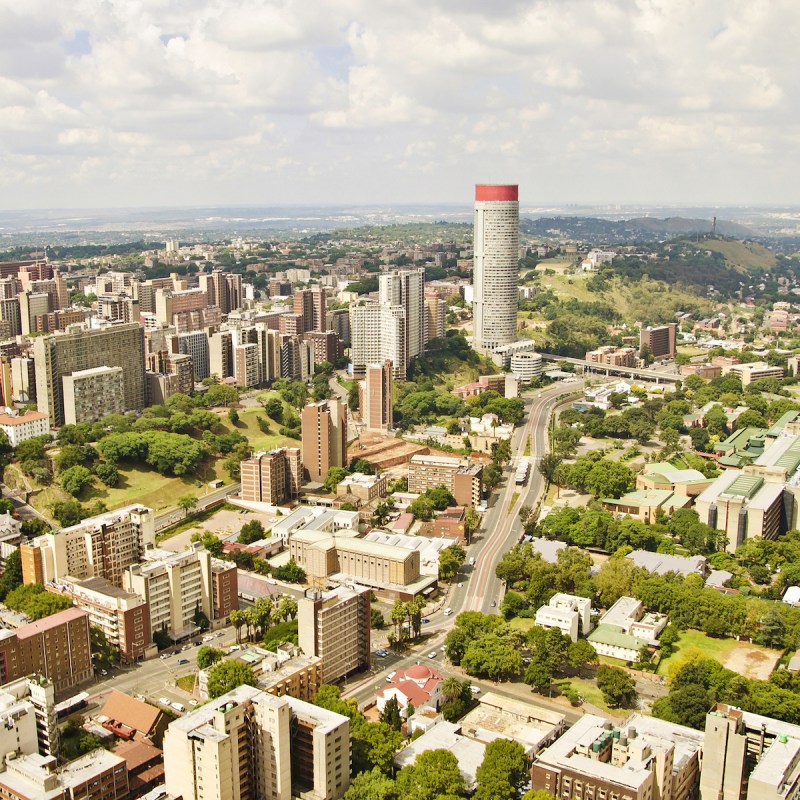
Jo’burg, or Jozi as locals affectionately call it, or sometimes E’Goli or the “City of Gold” because of its historical links to gold mining — how much do you know about the city of Johannesburg? Located in the eastern part of the country, Johannesburg is a massive city, the largest in South Africa. It is South Africa’s financial center, a city that has shaped the country’s history and politics, and one that is filled with treasures.
Videos by TravelAwaits
Often overlooked in favor of other more picturesque parts of South Africa, Johannesburg is often just a stopover for international tourists, being home to O.R. Tambo International Airport, the busiest airport on the African continent. Often the jumping-off point for a safari and mostly enjoyed on a quick layover, Johannesburg is a city of contrasts. On one hand, there’s the poverty and struggles of Soweto, and on the other, there are the glitzy skyscrapers and “super homes” of Sandton, which is often referred to as Africa’s richest square mile. Despite its complicated past, the City of Gold has a lot to offer tourists.
There’s a lot to see, do, and learn here, much more than you may imagine. Read on for my top tips for things to do in Johannesburg.

1. The City Center
A great way to start your Johannesburg experience is by heading into the city center, which is full of historic buildings. The city’s reputation can make it a bit intimidating for solo travel, so a good option for getting a feel for South Africa’s biggest and richest city is by joining the safety and security of a guided walking tour. Visit Chancellor House, where Nelson Mandela and Oliver Tambo set up South Africa’s first black-owned law firm. Get a 360-degree view of Johannesburg from the Carlton Centre, a 50-story skyscraper located in central Johannesburg. Admire heritage buildings on historic Main Street. Visit the Workers Museum and Museum Africa. Get a feel for the hustle and bustle of the people, lifestyle, and culture of this complex city.

2. Constitution Hill
If you’re visiting South Africa, spend some time learning about apartheid — a brutal period of national segregation that lasted 43 years. A visit to Constitution Hill will give you a better understanding of this troubled era.
Constitution Hill was once a notorious complex of prisons, known as “The Fort,” where political activists and ordinary citizens alike were incarcerated throughout the apartheid era. Thousands of men and women — of all races, ages, social statuses, and political beliefs, including Nelson Mandela and Mahatma Gandhi — were imprisoned and tortured here.
Constitution Hill overlooks the city and has been transformed into beautiful, thought-provoking museums focussing on the promotion of human rights. Some interesting exhibits include Number Four Museum (once male prisoner cells), the Old Fort Museum (where the whites-only prison was located), and the Women’s Gaol Museum. You’ll also have the opportunity to enter the still-functioning High Court, if no proceedings are in progress.
Visiting Constitution Hill will give you deeper insights into South Africa’s history and you should pair your visit with a tour of the Apartheid Museum, whose immersive exhibits explore this tragic time in more depth.

3. The Apartheid Museum
The Apartheid Museum will give you glimpses of apartheid, the laws of segregation according to racial groups, and South Africa’s painful journey to freedom.
On arrival, you’ll receive an entry ticket that will randomly classify you as white or non-white and you may only enter through the gate indicated for the race you have been allocated. That’s just to give you a taste of the reality of the past and set the atmosphere for the rest of your visit.
There are two main exhibitions in the Apartheid Museum, The Permanent Exhibition and The Mandela Exhibition, as well as rotating temporary exhibits that explore different aspects of the issue more in depth. The permanent exhibition takes you through some of the painful events of South Africa’s struggle for liberation. The Mandela Exhibition gives you an opportunity to learn about the leading statesman who was at the forefront of the country’s struggle against apartheid, including his time as a prisoner for 27 years.

4. Soweto Township
About 12 miles from Jo’burg center, Soweto is the largest township in South Africa with around 1.3 million inhabitants. During the apartheid regime, Soweto was at the heart of the movement to end apartheid and was a no-go area for tourists. More recently, the South African government has focussed on developing tourism in Soweto, making it a safe, dynamic, and interesting place to visit with some wonderful historical areas to explore, as well as an up-and-coming adventure sports scene.
The best way to experience Soweto is on a guided tour with someone who’ll take you to the main landmarks and tell you about their relevance, including Vilakazi Street, the only street in the world to have housed two Nobel Peace Prize winners (Nelson Mandela and Archbishop Desmond Tutu).
If you’re looking for a different side of the township, check out the activities at Soweto Towers. These striking structures, which were once part of a power station, now serve as an entertainment center and adrenaline-junky paradise. Bungee jumping, from a 328-foot-high suspension bridge, is the big attraction here. You can also try paintball or base jumping.

5. Maboneng Precinct
Another fun thing to do in Johannesburg is take a tour of the “super cool” Maboneng Precinct. Once a rundown part of town, a renovation project has turned it into an up-and-coming neighborhood where you’ll find great restaurants, cafés, bars, boutiques, and art galleries. Maboneng is a Sesotho word meaning “place of lights,” and the name perfectly describes the district. It is Johannesburg’s downtown fashion corner, buzzing lifestyle playground, and one of the city’s major creative hubs. Maboneng is filled with remarkable works of art, beautiful murals, and colorful graffiti.

6. The Walter Sisulu National Botanical Gardens
If you’re looking for something a little more “natural,” you’ll find plenty to enjoy at the Botanical Gardens. There are nine national botanical gardens in South Africa, and the Walter Sisulu, with its 200 acres of greenery and seven gardens of local and international plants, is one of them.
Highlights include the Witpoortjie Waterfall, Birds and Butterfly Garden, Fern Trail, Children’s Garden, Herb Garden, and the impressive array of desert plants in the Succulent Garden. If you’re a theater fan, spend some time in the Shakespeare Garden, which is filled with plants and herbs that were featured in the bard’s plays. The gardens are a great place to unwind and enjoy a bit of nature in the heart of the city.
7. Art Galleries
Located in Joubert Park, Johannesburg Art Gallery is one of the best art spots to visit in Johannesburg. With an impressive collection of art, including prints that date back to the 15th century, it features works of artists such as Dali and Picasso, and a section dedicated to local artists as well. Then, make your way over to the Wits Art Museum. Located on the University of the Witwatersrand Johannesburg campus, the Wits Art Museum houses 15,000 works spanning from the 19th century to the modern day.
Another excellent art venue in the city is the Goodman Gallery which focuses specifically on art with a social justice component. Its exhibits highlight emerging artists who are regarded as having helped shape the landscape of contemporary art in South Africa.

8. Food Tours
Johannesburg is often said to be the foodie capital of South Africa, but if you want to go for something super-traditional, opt for a typical African meal in Soweto, Yeoville, or Maboneng.
South Africa’s rich cultural heritage is reflected in its food and one of the coolest things to do in Johannesburg is to enjoy the cuisine. Local delicacies can include chicken neck, chicken feet, pigs’ trotters, and tripe, all accompanied by the unmissable paap — a ground-maize dish quite similar to polenta. Check out the Taste of Africa food tour which will get you sampling a variety of Pan-African restaurants in the thriving Yeoville neighborhood.
9. Tee Off
Had enough art, culture, or food and want to stretch your legs — how about teeing off at one of the best golf courses in Johannesburg? The Royal Johannesburg Golf Club, which has been running since 1890, offers two championship-level courses. At the Bryanston Country Club, there are a variety of greens for people of all skill levels, complete with plenty of entertaining water hazards. The links at Observatory Golf Course feature challenging holes and are committed to making the sport affordable for average individuals.
Whether you’re looking for adventure, relaxation, vibrant nightlife, great restaurants, or renowned cultural institutions, Johannesburg boasts a rich history and culture with museums, galleries, and historical sites to explore. A visit to Johannesburg is bound to make your stay in South Africa a memorable one.
Related Reading:

